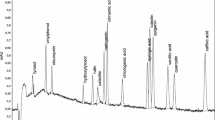Abstract
Polar extracts of extra-virgin olive oils (EVOO) contain a large number of phenolic compounds with antioxidant properties. The antioxidant capacity can be measured by different reaction mechanisms, as the single electron transfer (SET) or the hydrogen atom transfer (HAT). In this work, the total phenolic content (TPC) by the Folin-Ciocalteu method and its correlation with four antioxidant capacity assays (FRAP, ABTS, DPPH• and ORAC) were evaluated for EVOO polar extracts. It was observed that the higher the total phenolic compounds in the EVOO extracts, the higher the antioxidant capacities, regardless of the method employed. The reaction mechanism observed for TPC by Folin-Ciocalteu method and also for FRAP, ABTS and DPPH• antioxidant capacity assays is a single electron transfer, thus, a high correlation among their results is expected. However, the correlation between TPC and ORAC results was also high and significant, allowing to conclude that EVOO phenolic compounds are able to react by the hydrogen atom transfer mechanism, which indicates that they can act as effective radical chain-breaking antioxidants. These results suggest that, for the EVOO polar extracts, TPC by Folin-Ciocalteu and ORAC assays could be sufficient to evaluate their in vitro antioxidant capacity.


Similar content being viewed by others
References
EC Regulation 1513 (2001) Off J Eur Com (L 201, 26th Jul 2003)
Carrasco-Pancorbo A, Cerretani L, Bendini A, Segura-Carretero A, Del Carlo M, Gallina-Toschi T, Lercker G, Compagnone D, Fernández-Gutiérrez A (2005) Evaluation of the antioxidant capacity of individual phenolic compounds in virgin olive oil. J Agric Food Chem 53:8918–8925
Brewer MS (2011) Natural antioxidants: sources, compounds, mechanisms of action, and potential applications. Compr Rev Food Sci Food Saf 10:221–247
Fu L, Xu B-T, Xu X-R, Gan R-Y, Zhang Y, Xia E-Q, Li H-B (2011) Antioxidant capacities and total phenolic contents of 62 fruits. Food Chem 129:345–350
Huang D, Ou B, Prior RL (2005) The chemistry behind antioxidant capacity assays. J Food Agric Food Chem 53:1841–1856
Tabart J, Kevers C, Pincemail J, Defraigne J-O, Dommes J (2009) Comparative antioxidant capacities of phenolic compounds measured by various tests. Food Chem 113:1226–1233
Nakbi A, Issaoui M, Dabbou S, Koubaa N, Echbili A, Hammami M, Attia N (2010) Evaluation of antioxidant activities of phenolic compounds from two extra virgin olive oils. J Food Compos Anal 23:711–715
Singleton VL, Orthofer R, Lamuela-Raventos RM (1999) Analysis of total phenols and other oxidation substrates and antioxidants by means of Folin-Ciocalteu reagent. Methods Enzimol 299:152–178
Benzie IFF, Strain JJ (1996) The ferric reducing ability of plasma as a measure of “antioxidant power”: the FRAP assay. Anal Biochem 239:70–76
Re R, Pellegrini N, Proteggente A, Pannala A, Yang M, Rice-Evans C (1999) Antioxidant activity applying an improved ABTS radical cation decolorization assay. Free Radic Biol Med 26:1231–1237
Brand-Williams W, Cuvelier ME, Berset C (1995) Use of a free radical method to evaluate antioxidant activity. Lebensm-Wiss Technol 28:25–30
Ou B, Hampsch-Woodill M, Prior RL (2001) Development and validation of an improved oxygen radical absorbance capacity assay using fluorescein as the fluorescent probe. J Agric Food Chem 49:4619–4626
Huang D, Ou B, Hampsch-Woodill M, Flanagan JA, Prior RL (2002) High-Throughput assay of oxygen radical absorbance capacity (ORAC) using a multichannel liquid handling system coupled with a microplate fluorescence reader in 96-well format. J Agric Food Chem 50:4437–4444
Dávalos A, Gómez-Cordovés C, Bartolomé B (2004) Extending applicability of the oxygen radical absorbance capacity (ORAC-fluorescein) assay. J Agric Food Chem 52:48–54
Ninfali P, Aluigi G, Bacchiocca M, Magnani M (2001) Antioxidant capacity of extra-virgin olive oils. J Am Oil Chem Soc 78:243–247
Andjelkovic M, Van Camp J, Pedra M, Renders K, Socaciu C, Verhé R (2008) Correlations of the phenolic compounds and the phenolic content in some Spanish and French olive oils. J Agric Food Chem 56:5181–5187
Loizzo MR, Di Lecce G, Boselli E, Menichini F, Frega NG (2012) Radical scavenging, total antioxidant capacity, and antiproliferative activity of phenolic extracts from extra virgin olive oil by cultivar ‘Frantoio’. Int J Food Prop 15:1345–1357
Fuentes E, Báez ME, Bravo M, Cid C, Labra F (2012) Determination of total phenolic content in olive oil samples by UV-visible spectrometry and multivariate calibration. Food Anal Meth 5:1311–1319
Samaniego Sánchez C, Troncoso González AM, García-Parrilla MC, Quesada Granados JJ, López García De La Serrana H, López Martínez MC (2007) Different radical scavenging tests in virgin olive oil and their relation to the total phenol content. Anal Chim Acta 593:103–107
Cicerale S, Lucas LJ, Keast RSJ (2012) Antimicrobial, antioxidant and anti-inflammatory phenolic activities in extra virgin olive oil. Curr Opin Biotechnol 23:129–135
Valavanidis A, Nisiotou C, Papageorgiou Y, Kremli I, Satravelas N, Zinieris N, Zygalaki H (2004) Comparison of the radical scavenging potential of polar and lipidic fractions of olive oil and other vegetable oils under normal conditions and after thermal treatment. J Agric Food Chem 52:2358–2365
Ninfali P, Bacchiocca M, Biagiotti E, Servili M, Montedoro G (2002) Validation of the oxygen radical absorbance capacity (ORAC) parameter as a new index of quality and stability of virgin olive oil. J Am Oil Chem Soc 79:977–982
Acknowledgments
We would like to thank FAPESP–Fundação de Amparo à Pesquisa do Estado de São Paulo (processes 08/57548-0 and 13/25242-7), CNPq–Coordenação Nacional de Desenvolvimento Científico e Tecnológico (process 140965/2010-6) and CAPES–Coordenação de Aperfeiçoamento de Pessoal de Nível Superior, for their financial support.
Author information
Authors and Affiliations
Corresponding authors
About this article
Cite this article
Ballus, C.A., Meinhart, A.D., de Souza Campos, F.A. et al. Total Phenolics of Virgin Olive Oils Highly Correlate with the Hydrogen Atom Transfer Mechanism of Antioxidant Capacity. J Am Oil Chem Soc 92, 843–851 (2015). https://doi.org/10.1007/s11746-015-2629-0
Received:
Revised:
Accepted:
Published:
Issue Date:
DOI: https://doi.org/10.1007/s11746-015-2629-0




